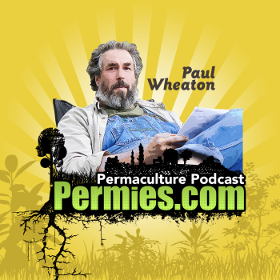 Listen Online
Listen Online  Download
Download  Get all of the Podcasts in convenient, giant zip files
Get all of the Podcasts in convenient, giant zip files  Subscribe on iTunes
Subscribe on iTunes Summary
Summary
Paul consults with Tim Kostamo about his property on an island in British Columbia.
It's 10 acres, with a lot of trees: cedar, maple, conifer, alder. The climate isn't extreme: It freezes at times in winter but doesn't get too hot in summer. The soil is poor, mostly sand and gravel with a lot of precipitation: around 99in per year but still it can be dry in summer for 2-3 months.
There are 2 cabins on the property, one of which is the Sauna, both have wood stoves, and a lake fed by a stream, which Tim made for swimming. Tim works and lives in Vancouver, so although he goes to the property quite frequently won't be there full time.
Paul suggests removing the conifers which are bad for the soil. Alder is good: it fixes nitrogen. Conifers and cedars can be cut and the wood stacked to dry for later building: Tim has plans to add more cabins. Paul also says to save all the wood ash which will be useful.
Paul suggests working on a quarter acre per year. Pick a good spot close to the cabin for zone 1, remove trees to let plenty of light in, and the wood that isn't cedar can be used in hügelkuturs. The hügelkuturs should generally run up and down a slope so as not to create frost traps, but it looks nicer if they aren't all straight. Paul talks about blotch: when building hügelkuturs don't aim to spread material around evenly, but instead clump like material together in blotches. This makes diversity to grow different plants.
Hügelkuturs should be built tall and steep. To do this the wood needs laying in different directions each layer: Tim is a surgeon, so he knows that things need a good skeleton.
They discuss the issue that deer and other creatures will come to eat the garden. Paul describes deer fences including the wavy fence favored by Mike Haasl, co-author of the SKIP book. Apparently it's successful in keeping out deer; Tim likes the idea of wavy lines.
Paul says it will be hard to build good soil in that climate, and for the first year or two the hügelkuturs will need irrigation in summer and to plant things that add carbon and nitrogen to the soil. Once up and running the hügelkuturs can be planted with more perennials and shouldn't need irrigation.
There's also a suggestion to make a deliberate cold trap to grow apples and pears.
Relevant Threads
Hugelkultur forum
Great White North forum - containing British Colombia
Mike Haasl's Wavy Deer Fence thread
Support the Empire
Help support the empire and get all of the podcasts in a bundle
here in the digital market at permies.
To support production of these podcasts, make a donation
here at Paul's Patreon page.
 This podcast was made possible thanks to:
This podcast was made possible thanks to:
Dr. Hugh Gill Kultur
Kyle Neath
Bill Crim
anonymous
Chris Sugg
Kerry JustTooLazy
Jocelyn Campbell
Bill Erickson
Sasquatch
G Cooper
Dominic Crolius
Penny McLoughlin
Mehron Kugler
Pasquale DeAngelis
havokeachday
Julia Winter, world's slowest mosaic artist
Greg Martin
Mark
Sean Benedict
Rita Bliden
Dana Martin
Candace Dahlk
Keith Kuhnsman
Leanne
Eric Tolbert
Nick DePuy
Nathan Hale
Opalyn Rose
Polly Jayne Smyth
Todd Gerardot
Katie Young
Ivar Vasara
Brent Lawson
Weston prestage
Candice Crawford
Chris Holtslag
Song Zheng

